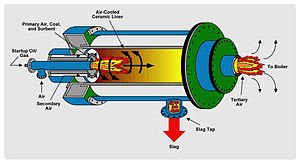User:BlatantHeroics/Sandbox



A combustor is a component or area of a gas turbine, ramjet or pulsejet engine where combustion takes place. It is also known as a burner or flame can depending on the design. In a gas turbine engine, the main combustor or combustion chamber is feed high pressure air by the compression system and feed the hot exhaust flows into the turbine components of the gas generator.
Combustor are designed to contain and control the burning fuel-air mixture. The combustor normally consists of three components: an outer casing that acts as a high pressure container, the combustion chamber itself which contains the flame and the fuel injection system.
Physical considerations
[edit]Since the normal velocity of the incoming airflow far exceeds the flame propagation velocity, the combustor is designed to produce an area of low velocity airflow (Mach~0.05) where the fuel and air can be mixed and stably burnt. This area of the combustor is sometimes called a flame holder and allows a stable flame front to be established and maintained. At the flame holder the fuel and the air are injected at a constant equivalence ratio. The fuel and air are intermixed by means of spraying the fuel so that it forms small droplets. Then the speed of the flow is reduced in a diffuser so that it is slower than the flame front speed in this air-droplet mixture. The exhaust is too hot for the guiding vanes and the turbines, so that they have to emit plenty of cooling air on their leading edges, which is then sometimes used in the afterburner to burn more fuel. Again in the afterburner the speed of the flow has to be very low. Often the flame-front area is enlarged by turbulence or folding.
Types of combustors
[edit]There are two categories of combustors, annular and can. Can combustors look like cans and are mounted around the engine. They can be easily removed for maintenance and provide convenient plumbing for fuel. Annular combustors are more compact and embedded deep within the engine's casing. Modern Jet engines usually have annular combustors. Double annular combustors are being introduced to reduce emissions. At low throttle settings, one of the two discrete volumes in the combustor is unfuelled.
Small gas turbine engines often have a reverse flow combustor, which is a very compact design. The gas path, from high radius entry to low radius exit, is 'S' shaped.
Afterburners
[edit]Some, mainly military, turbojets and turbofans have an afterburner located in the tailpipe, to provide thrust augmentation during Take-off and Combat. On unmixed turbofans, 'afterburning' in the bypass stream is often called Plenum Chamber Burning.
Rockets
[edit]Combustors in rocket engines operate outside of the main rocket chamber and will usually be handling pre-combustion of fuel and LOX so that the mixture burns completely in the rocket motor combustion chamber.
Scramjets
[edit]In scramjet engines the combustor inlet flow is supersonic. Only a few practical scram-jets have flown and their details are mostly classified. However, hydrogen fuel is believed to be injected into a sheltered region, below a reverse-facing step. Unlike a conventional combustor, the Mach number of the flow decreases going through the combustor.
